Further Widening or Bridging the Gap? A Cross-Regional Study of Unemployment across the EU Amid Economic Crisis
Abstract
:1. Introduction
2. Materials and Methods
2.1. Materials
2.1.1. Spatial Data
2.1.2. Non-Spatial Data
2.2. Methods
- identification of how ROU is spatially distributed in 2008 and 2013 by using global and local Moran’s I and local Getis-Ord Gi*;
- identification of the spatio-temporal autocorrelation of ROU between 2008 and 2013 by using bivariate local Moran’s I. In other words, it is estimated how ROU in a specific location in 2008 affects the ROU of nearby locations in 2013;
- ascertaining whether the changes in the ROU over time are spatially and temporarily clustered using differential local Moran’s I;
- providing useful findings for policy makers and spatial planners to design successful policies that will mitigate high values of the ROU in order to achieve a more sustainable future.
2.2.1. Incremental Spatial Autocorrelation and Global Moran’s I
2.2.2. Local Moran’s I
2.2.3. Bivariate Local Moran’s I—Spatio-Temporal Autocorrelation
2.2.4. Differential Moran’s I
2.2.5. Getis-Ord Gi*
2.2.6. False Discovery Rate
3. Results
3.1. Statistical Analysis of ROU2008 and ROU2013
3.2. Setting the Neighborhood Size: Incremental Spatial Autocorrelation
3.3. Spatial Autocorrelation Analysis of ROU for 2008 and 2013: Local Moran’s I
3.4. ROU Hot Spot Analysis for 2008 and 2013: Getis-Ord Gi*
3.5. ROU Spatio-Temporal Autocorrelation 2008–2013: Bivariate Local Moran’s I
3.6. ROU Spatio-Temporal Autocorrelation 2008–2013: Differential Local Moran’s I
4. Discussion and Conclusions
Funding
Conflicts of Interest
References
- Torres, R.; International Labour Organisation; International Institute for Labour Studies. World of Work Report 2011: Making Markets Work for Jobs; ILO: Geneva, Switzerland, 2011. [Google Scholar]
- Eurostat European Commission. Regions in the European Union. Nomenclature of Territorial Units for Statistics; NUTS 2013/EU-28; Publication Office of the European Union: Luxembourg, 2013; Available online: http://ec.europa.eu/eurostat/documents/3859598/6948381/KS-GQ-14-006-EN-N.pdf (accessed on 10 January 2018).
- Brand, J.E.; Burgard, S.A. Job displacement and social participation over the lifecourse: Findings for a cohort of joiners. Soc. Forces 2008, 87, 211–242. [Google Scholar] [CrossRef] [PubMed]
- Gregg, P.; Tominey, E. The wage scar from male youth unemployment. Labour Econ. 2005, 12, 487–509. [Google Scholar] [CrossRef]
- Dieckhoff, M.; Gash, V. Unemployed and alone? Unemployment and social participation in Europe. Int. J. Sociol. Soc. Policy 2015, 35, 67–90. [Google Scholar] [CrossRef]
- Buffel, V.; Van de Velde, S.; Bracke, P. The mental health consequences of the economic crisis in Europe among the employed, the unemployed, and the non-employed. Soc. Sci. Res. 2015, 54, 263–288. [Google Scholar] [CrossRef] [PubMed] [Green Version]
- Gialis, S.; Taylor, M. A regional account of flexibilization across the EU: The ‘flexible contractual arrangements’ composite index and the impact of recession. Soc. Indic. Res. 2016, 128, 1121–1146. [Google Scholar] [CrossRef]
- Castells-Quintana, D.; Royuela, V. Unemployment and long-run economic growth: The role of income inequality and urbanisation. Investig. Reg. 2012, 24, 153–173. [Google Scholar]
- Stiglitz, J. The global crisis, social protection and jobs. Int. Labour Rev. 2013, 152, 93–106. [Google Scholar] [CrossRef]
- Brescia, R.H. The cost of inequality: Social distance, predatory conduct, and the financial crisis. N. Y. Univ. Annu. Surv. Am. Law 2010, 66, 641. [Google Scholar]
- Cracolici, M.; Cuffaro, M.; Nijkamp, P. A spatial analysis on Italian unemployment differences. Stat. Methods Appl. 2009, 18, 275–291. [Google Scholar] [CrossRef] [Green Version]
- López-Bazo, E.; del Barrio, T.; Artis, M. Geographical distribution of unemployment in Spain. Reg. Stud. 2005, 39, 305–318. [Google Scholar] [CrossRef]
- Vega, S.H.; Elhorst, J.P. A regional unemployment model simultaneously accounting for serial dynamics, spatial dependence and common factors. Reg. Sci. Urban Econ. 2016, 60, 85–95. [Google Scholar] [CrossRef]
- Pesaran, M.H. Estimation and inference in large heterogeneous panels with a multifactor error structure. Econometrica 2006, 74, 967–1012. [Google Scholar] [CrossRef]
- Marelli, E.; Patuelli, R.; Signorelli, M. Regional unemployment in the EU before and after the global crisis. Post-Communist Econ. 2012, 24, 155–175. [Google Scholar] [CrossRef]
- Signorelli, M. Employment and unemployment in a multilevel regional perspective. In L’Europe Me’Diterrane’Enne—Mediterranean Europe; Petricioli, M., Ed.; P.I.E. Peter Lang: Bruxelles, Belgium, 2008; pp. 175–200. [Google Scholar]
- Patuelli, R.; Schanne, N.; Griffith, D.A.; Nijkamp, P. Persistence of regional unemployment: Application of a spatial filtering approach to local labor markets in Germany. J. Reg. Sci. 2012, 52, 300–323. [Google Scholar] [CrossRef]
- Bailey, N.; Holly, S.; Pesaran, M.H. A Two-Stage Approach to Spatio-Temporal Analysis with Strong and Weak Cross-Sectional Dependence. J. Appl. Econ. 2016, 31, 249–280. [Google Scholar] [CrossRef]
- Chudik, A.; Pesaran, M.H.; Tosetti, E. Weak and strong cross-section dependence and estimation of large panels. Econ. J. 2011, 14, C45–C90. [Google Scholar] [CrossRef]
- Nijkamp, P. Regional development as self-organized converging growth. In Spatial Disparities and Development Policy; The World Bank Group: Washington, DC, USA, 2009; pp. 265–282. [Google Scholar]
- Oud, J.H.; Folmer, H.; Patuelli, R.; Nijkamp, P. Continuous-time modeling with spatial dependence. Geogr. Anal. 2012, 44, 29–46. [Google Scholar] [CrossRef]
- Andersson, D.E.; Andersson, Å.E.; Hårsman, B.; Daghbashyan, Z. Unemployment in European regions: Structural problems versus the Eurozone hypothesis. J. Econ. Geogr. 2015, 15, 883–905. [Google Scholar] [CrossRef]
- Doran, J.; Fingleton, B. Employment resilience in Europe and the 2008 economic crisis: Insights from micro-level data. Reg. Stud. 2016, 50, 644–656. [Google Scholar] [CrossRef]
- Patacchini, E.; Zenou, Y. Spatial dependence in local unemployment rates. J. Econ. Geogr. 2007, 7, 169–191. [Google Scholar] [CrossRef]
- LeSage, J.P.; Pace, R.K. Introduction to Spatial Econometrics; Taylor and Francis: Boca Raton, FL, USA, 2009. [Google Scholar]
- Gilmartin, M.; Korobilis, D. On regional unemployment: An empirical examination of the determinants of geographical differentials in the UK. Scott. J. Political Econ. 2012, 59, 179–195. [Google Scholar] [CrossRef]
- Rafferty, A.; Rees, J.; Sensier, M.; Harding, A. Growth and recession: Underemployment and the labour market in the North of England. Appl. Spat. Anal. Policy 2013, 6, 143–163. [Google Scholar] [CrossRef]
- Schwarz, P. Neighborhood effects of high unemployment rates: Welfare implications among different social groups. J. Socio-Econ. 2012, 41, 180–188. [Google Scholar] [CrossRef]
- López-Bazo, E.; Motellón, E. The regional distribution of unemployment: What do micro-data tell us? Pap. Reg. Sci. 2013, 92, 383–405. [Google Scholar] [CrossRef]
- Beyer, R.C.; Stemmer, M.A. Polarization or convergence? An analysis of regional unemployment disparities in Europe over time. Econ. Model. 2016, 55, 373–381. [Google Scholar] [CrossRef]
- Netrdová, P.; Nosek, V. Spatial patterns of unemployment in Central Europe: Emerging development axes beyond the Blue Banana. J. Maps 2016, 12, 701–706. [Google Scholar] [CrossRef]
- Blažek, J.; Netrdová, P. Regional unemployment impacts of the global financial crisis in the new member states of the EU in Central and Eastern Europe. Eur. Urban Reg. Stud. 2012, 19, 42–61. [Google Scholar] [CrossRef]
- Grekousis, G.; Mountrakis, G. Sustainable development under population pressure: Lessons from developed land consumption in the conterminous US. PLoS ONE 2015. [Google Scholar] [CrossRef] [PubMed]
- GISCO. Geographical Information and Maps. 2015. Available online: http://ec.europa.eu/eurostat/web/gisco/geodata/reference-data/administrative-units-statistical-units/nuts#nuts13 (accessed on 10 January 2017).
- Lloyd, C.D. Local Models for Spatial Analysis; CRC Press: Boca Raton, FL, USA, 2010. [Google Scholar]
- Rey, S.J. Space–Time Patterns of Rank Concordance: Local Indicators of Mobility Association with Application to Spatial Income Inequality Dynamics. Ann. Am. Assoc. Geogr. 2016, 106, 788–803. [Google Scholar] [CrossRef]
- Anselin, L. A Local Indicator of Multivariate Spatial Association: Extending Geary’s C. Center for Spatial Data Science, University of Chicago. 2017. Available online: https://s3.amazonaws.com/geoda/docs/LA_multivariateGeary1.pdf (accessed on 8 January 2018).
- Yamada, I.; Thill, J.C. Local indicators of network-constrained clusters in spatial point patterns. Geogr. Anal. 2007, 39, 268–292. [Google Scholar] [CrossRef]
- Anselin, L. Local indicators of spatial association—LISA. Geogr. Anal. 1995, 27, 93–115. [Google Scholar] [CrossRef]
- Getis, A.; Ord, J.K. The analysis of spatial association by use of distance statistics. Geogr. Anal. 1992, 24, 189–206. [Google Scholar] [CrossRef]
- Benjamini, Y.; Hochberg, Y. Controlling the false discovery rate: A practical and powerful approach to multiple testing. J. R. Stat. Soc. Ser. B Methodol. 1995, 57, 289–300. [Google Scholar]
- Benjamini, Y. Discovering the false discovery rate. J. R. Stat. Soc. Ser. B Stat. Methodol. 2010, 72, 405–416. [Google Scholar] [CrossRef]
- Caldas de Castro, M.; Singer, B.H. Controlling the false discovery rate: A new application to account for multiple and dependent tests in local statistics of spatial association. Geogr. Anal. 2006, 38, 180–208. [Google Scholar] [CrossRef]
- Goovaerts, P. How do multiple testing correction and spatial autocorrelation affect areal boundary analysis? Spat. Spatio-Temporal Epidemiol. 2010, 1, 219–229. [Google Scholar] [CrossRef] [PubMed]
- O’Sullivan, D.; Unwin, D. Geographic Information Analysis, 2nd ed.; Wiley: Hoboken, NJ, USA, 2010. [Google Scholar]
- Anselin, L. Exploring spatial data with GeoDaTM: A workbook. Urbana 2004, 51, 309. [Google Scholar]
- Garcilazo, J.E.; Spiezia, V. Regional Unemployment Clusters: Neighborhood and State Effects in Europe and North America. Rev. Reg. Stud. 2007, 37, 282–302. [Google Scholar]
- Hadjimichalis, C. Uneven geographical development and socio-spatial justice and solidarity: European regions after the 2009 financial crisis. Eur. Urban Reg. Stud. 2011, 18, 254–274. [Google Scholar] [CrossRef]
- Davies, S. Regional resilience in the 2008–2010 downturn: Comparative evidence from European countries. Cambr. J. Reg. Econ. Soc. 2011, 4, 369–382. [Google Scholar] [CrossRef]
- Jurajda, Š.; Terrell, K. Regional Unemployment and Human Capital in Transition Economies. Econ. Transit. 2009, 17, 241–274. [Google Scholar] [CrossRef]
- Antelo, M.; Magdalena, P.; Reboredo, J.C. Economic crisis and the unemployment effect on household food expenditure: The case of Spain. Food Policy 2017, 69, 11–24. [Google Scholar] [CrossRef]
- Anthopoulou, T.; Kaberis, N.; Petrou, M. Aspects and experiences of crisis in rural Greece. Narratives of rural resilience. J. Rural Stud. 2017, 52, 1–11. [Google Scholar] [CrossRef]
- Hudson, R. Facing forwards, looking backwards: Coming to terms with continuing uneven development in Europe. Eur. Urban Reg. Stud. 2017, 24, 138–141. [Google Scholar] [CrossRef]
- Starace, F.; Mungai, F.; Sarti, E.; Addabbo, T. Self-reported unemployment status and recession: An analysis on the Italian population with and without mental health problems. PLoS ONE 2017, 12, e0174135. [Google Scholar] [CrossRef] [PubMed]
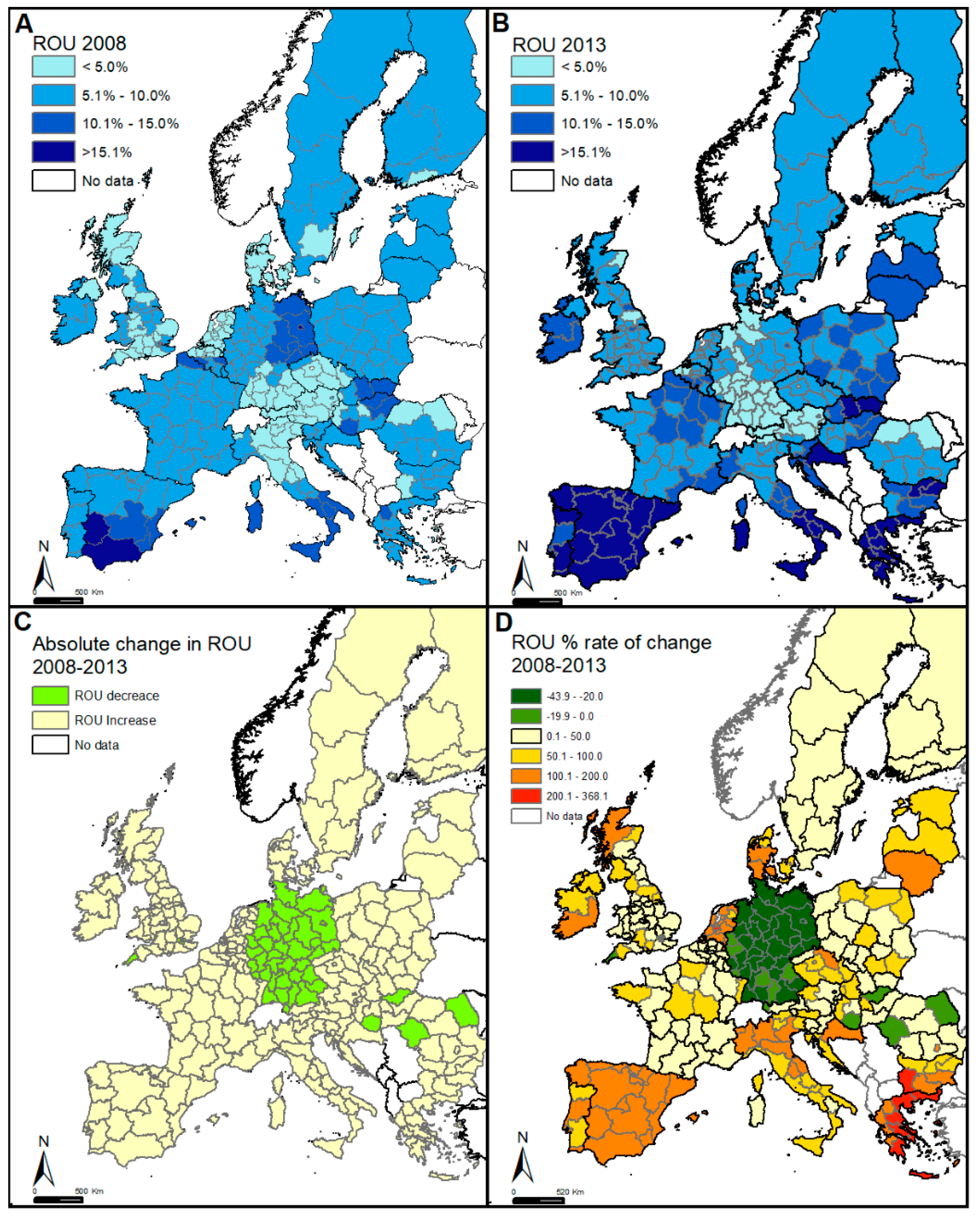
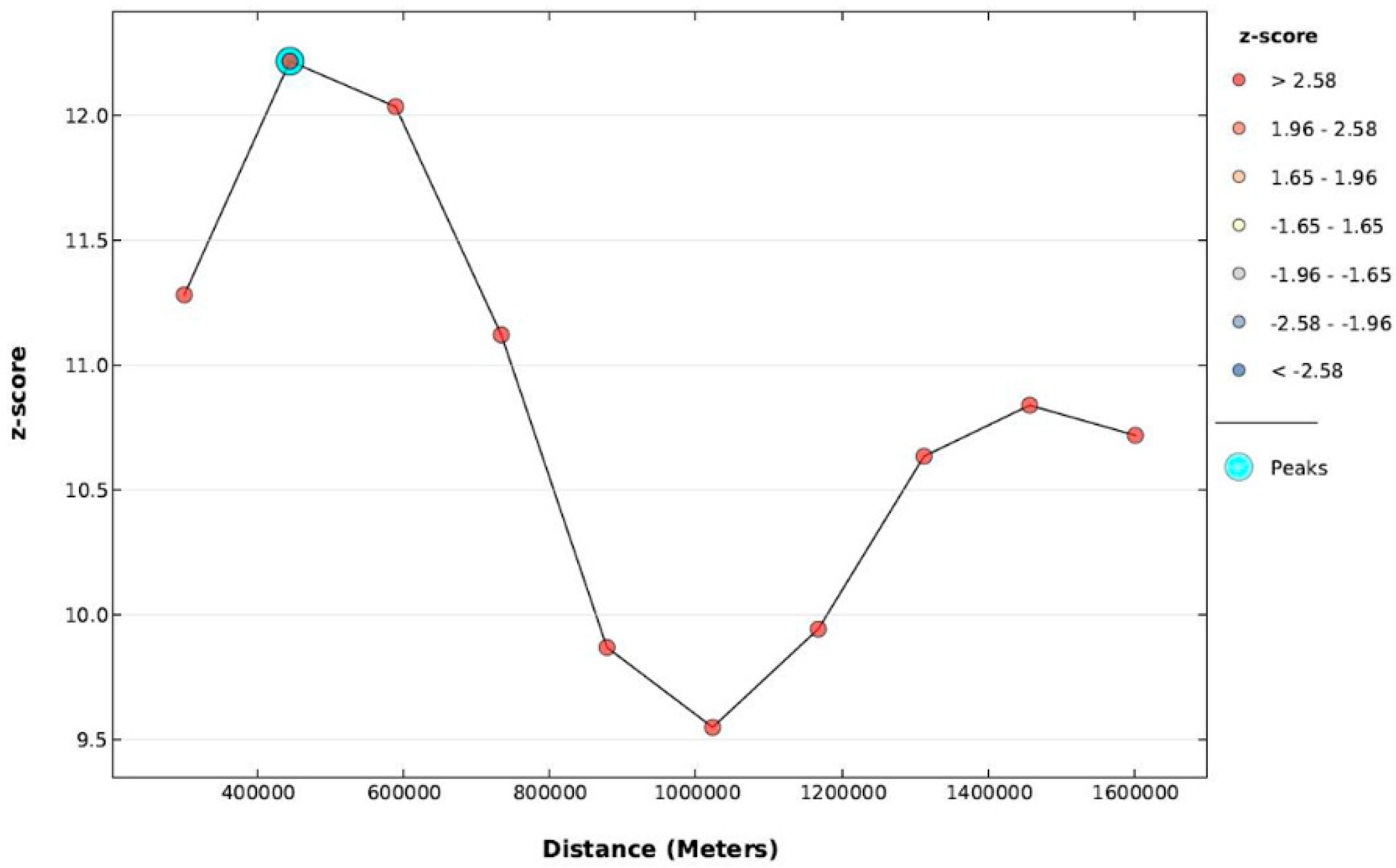
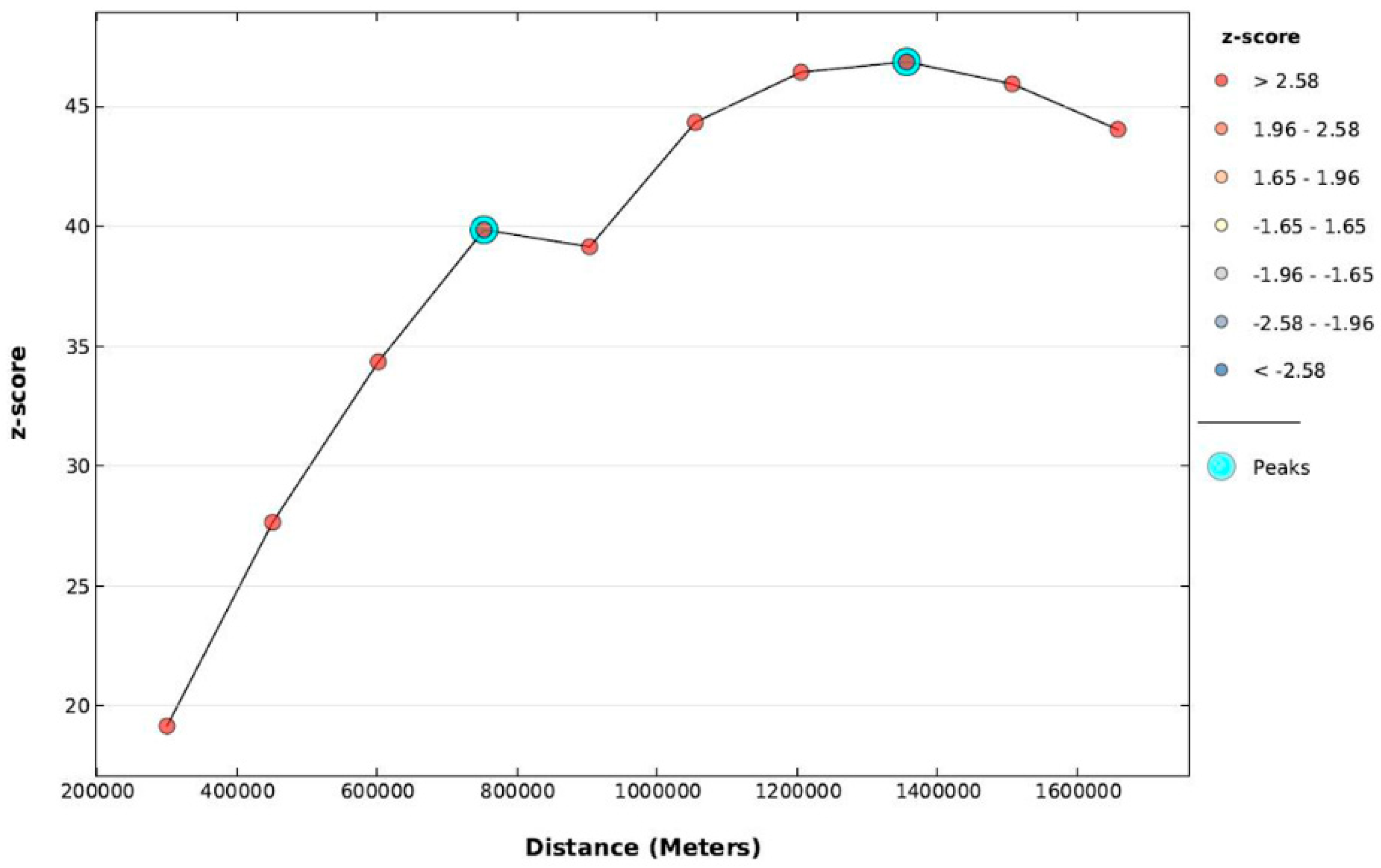
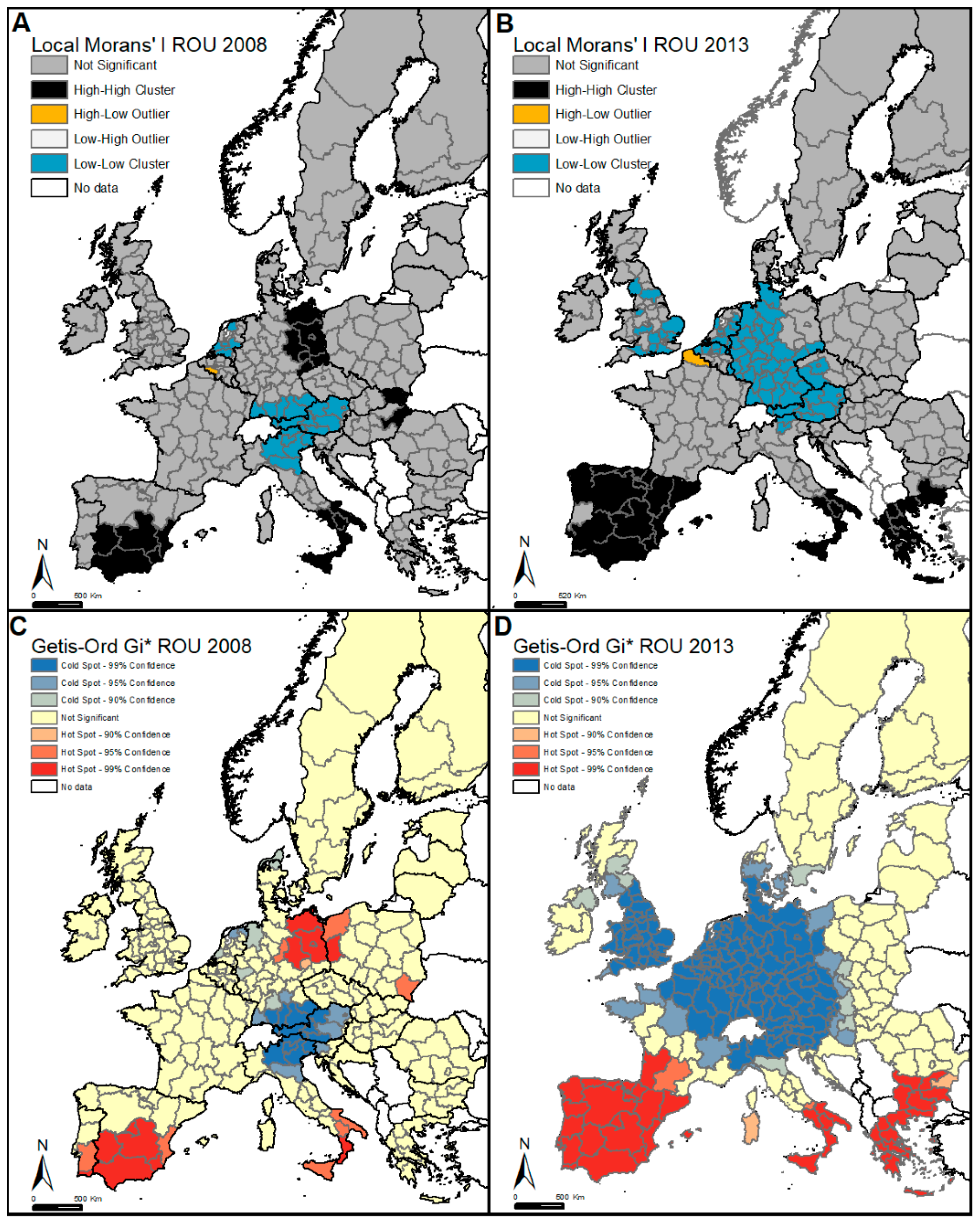
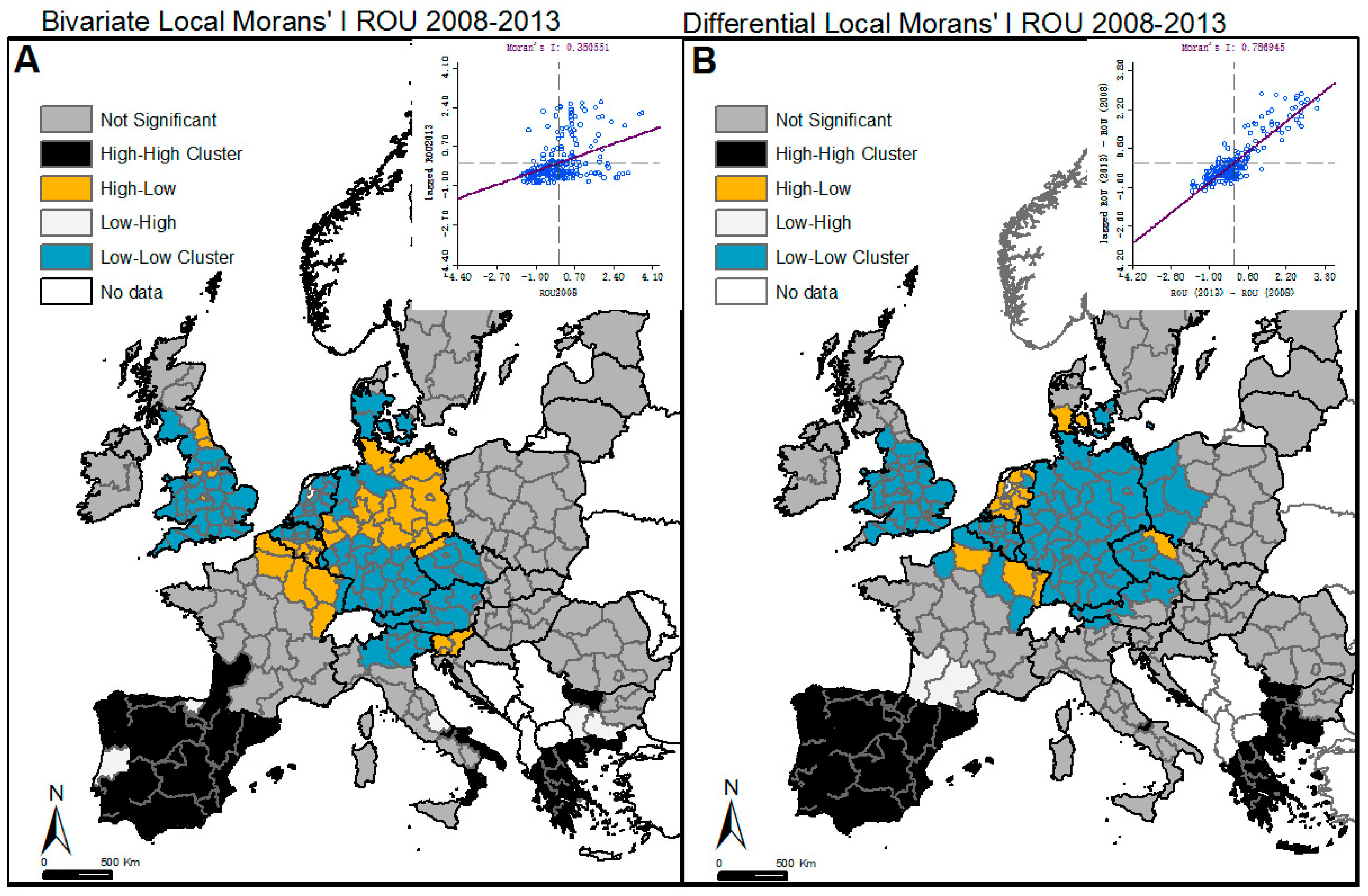
| Country | NUTS0 | NUTS2 Regions | Unemployment (in Thousands) | Change (in Thousands) | ROU (%) | ||
|---|---|---|---|---|---|---|---|
| 2008 | 2013 | 2013–2008 | 2008 | 2013 | |||
| Austria | AT | 9 | 172 | 231 | 59 | 4.1 | 5.4 |
| Belgium | BE | 11 | 333 | 417 | 84 | 7 | 8.4 |
| Bulgaria | BG | 6 | 202 | 436 | 234 | 5.6 | 13 |
| Czech Republic | CZ | 8 | 230 | 370 | 140 | 4.4 | 7 |
| Croatia | HR | 2 | 166 | 320 | 154 | 8.6 | 17.4 |
| Denmark | DK | 5 | 101 | 202 | 101 | 3.4 | 7 |
| Estonia | EE | 1 | 38 | 59 | 21 | 5.5 | 8.6 |
| Finland | FI | 5 | 172 | 219 | 47 | 6.4 | 8.2 |
| France | FR | 22 | 2121 | 3026 | 905 | 7.4 | 10.3 |
| Germany | DE | 38 | 3018 | 2182 | -836 | 7.4 | 5.2 |
| Greece | EL | 13 | 388 | 1330 | 942 | 7.8 | 27.5 |
| Hungary | HU | 7 | 326 | 441 | 115 | 7.8 | 10.2 |
| Ireland | IE | 2 | 146 | 282 | 136 | 6.4 | 13.1 |
| Italy | IT | 21 | 1664 | 3069 | 1405 | 6.7 | 12.1 |
| Latvia | LV | 1 | 88 | 120 | 32 | 7.7 | 11.9 |
| Lithuania | LT | 1 | 88 | 172 | 84 | 5.8 | 11.8 |
| Luxembourg | LU | 1 | 10 | 15 | 5 | 4.9 | 5.9 |
| Netherlands | NL | 12 | 318 | 647 | 329 | 3.7 | 7.3 |
| Poland | PL | 16 | 1165 | 1793 | 628 | 7.1 | 10.3 |
| Portugal | PT | 5 | 476 | 855 | 379 | 8.8 | 16.4 |
| Romania | RO | 8 | 549 | 653 | 104 | 5.6 | 7.1 |
| Slovenia | SI | 2 | 46 | 102 | 56 | 4.4 | 10.1 |
| Slovakia | SK | 4 | 254 | 386 | 132 | 9.6 | 14.2 |
| Spain | ES | 17 | 2596 | 6051 | 3455 | 11.3 | 26.1 |
| Sweden | SE | 8 | 305 | 411 | 106 | 6.2 | 8 |
| UK | UK | 40 | 1757 | 2437 | 680 | 5.6 | 7.5 |
| EU26 (study) | 265 | 16,729 | 26,226 | 9497 | |||
| EU28 | 276 | 16,751 | 26,304 | 9553 | 7 | 10.9 | |
© 2018 by the author. Licensee MDPI, Basel, Switzerland. This article is an open access article distributed under the terms and conditions of the Creative Commons Attribution (CC BY) license (http://creativecommons.org/licenses/by/4.0/).
Share and Cite
Grekousis, G. Further Widening or Bridging the Gap? A Cross-Regional Study of Unemployment across the EU Amid Economic Crisis. Sustainability 2018, 10, 1702. https://doi.org/10.3390/su10061702
Grekousis G. Further Widening or Bridging the Gap? A Cross-Regional Study of Unemployment across the EU Amid Economic Crisis. Sustainability. 2018; 10(6):1702. https://doi.org/10.3390/su10061702
Chicago/Turabian StyleGrekousis, George. 2018. "Further Widening or Bridging the Gap? A Cross-Regional Study of Unemployment across the EU Amid Economic Crisis" Sustainability 10, no. 6: 1702. https://doi.org/10.3390/su10061702




